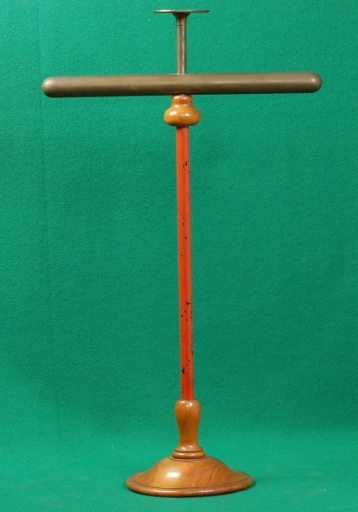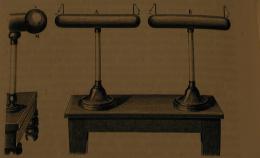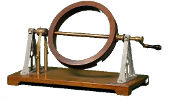» Insulated Cylindrical Conductor (0017)
Immagini


DESCRIPTION
The cylindrical conductors were used to test theories on induction and on the distribution of charges on conducting bodies. Bringing a charged sphere near a conductor caused it to be charged  by induction. The end facing the sphere acquired an opposite charge, while the other end acquired the same charge. The charge decreased when bringing the charged sphere near the midway point of the cylinder as can be easily demonstrated using two pith ball pendulums. This effect is due to the decreased curvature near the middle of these cylinders. In performing this experiment  very often a number of conductors in cascade were used to show the alternate  positive and negative charges at the ends of the cylinders. (the figure comes from Ganot [1]).  At the start of seventeenth century, bodies were divided into two classes: those that charged if rubbed with a skin were defined as insulators, others (eg. metals) as conductors. Actually all bodies are charged by rubbing: rubbing a metal rod with insulating handle causes it to become charged.  However, touching it with a hand quickly loses the ability to attract light bodies as the electric fluid flows through the body and goes to ground through the hand of the experimenter. Probably Grey in 1729 corrected the distinction between electric and non-electric bodies to the distinction between conductors and insulators. However throughout 1800 the use of the word electric fluid to refer to the electric current flow remained. Moreover, positive charge was defined as that acquired by  smooth glass when it is  rubbed with  wool and negative that acquired by resin in the same conditions [2].  More precisely, it was established that when two bodies are rubbed together the first body is charged positively whichever comes first in the following order : cat skin, feathers, silk, smooth glass, wood, shellac, wool, paper and frosted glass.BIBLIOGRAPHY
- [1] A. Ganot, "Traité Élémentaire de physique", Paris, 1868
- [2] A. Privat-Deschanel : Trattato elementare di fisica , Milano, Dumolard, 1882.
Dati Catalografici
| Data di costruzione: | --- |
|---|---|
| Data di carico: | Ignota |
| Nr. Inventario: | Ignoto (Ignoto) |
| Costruttore: | Sconosciuto |
| Materiale: | legno, vetro, ottone |
| Dimensioni: | Altezza complessiva: 60 cm; Conduttore: diametro 2,5 cm; lunghezza 35 cm |
| Conservazione: | buono |
